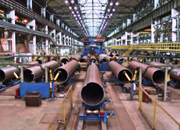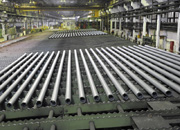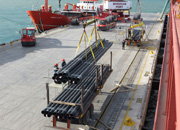In the world of steel,
carbon steel pipes and cold-rolled steel pipes are two common materials, each possessing unique characteristics and a wide range of applications.
First, let's understand carbon steel pipes. Carbon steel, as the name suggests, is a type of steel containing carbon, typically between 0.05% and 2.1%. The strength and hardness of carbon steel pipes increase with increasing carbon content, but at the same time, their plasticity and toughness decrease. Carbon steel pipes are widely classified, from low-carbon steel to high-carbon steel, each type having its specific uses.
Next, let's look at cold-rolled steel pipes. Cold-rolled steel pipes are seamless steel pipes manufactured at room temperature through a rolling process. Compared to hot-rolled steel pipes, cold-rolled steel pipes have a smoother surface, higher dimensional accuracy, and a denser internal structure. This gives cold-rolled steel pipes advantages in strength and corrosion resistance.
So, which is better, carbon steel pipes or cold-rolled steel pipes? This actually depends on your specific needs.
1. Strength and Hardness: If you require high strength and high hardness, high-carbon steel pipes are likely a better choice. High-carbon steel pipes have significantly higher hardness and strength than low-carbon steel pipes, making them suitable for manufacturing machine parts, tools, and bearings.
2. Plasticity and Toughness: If your application requires good plasticity and toughness, low-carbon steel pipes or cold-rolled steel pipes may be more suitable. Low-carbon steel pipes have good plasticity and toughness, making them suitable for manufacturing parts that require bending or forming. Cold-rolled steel pipes, due to their dense internal structure, also possess good toughness.
3. Surface Finish and Dimensional Accuracy: If you have high requirements for the surface finish and dimensional accuracy of the material, cold-rolled steel pipes are undoubtedly the best choice. Cold-rolled steel pipes have a significantly higher surface finish and dimensional accuracy than hot-rolled steel pipes, making them suitable for manufacturing precision instruments and equipment.
4. Cost Considerations: In terms of cost, low-carbon steel pipes are generally cheaper than cold-rolled steel pipes. If your project budget is limited, low-carbon steel pipes may be a more economical choice. However, considering the service life and maintenance costs of cold-rolled steel pipes, they may offer better cost-effectiveness in the long run.
5. Application Areas: Different application areas have different material requirements. For example, in automobile manufacturing, cold-rolled steel pipes are often used to manufacture body structures because they provide the required strength and rigidity. In the construction industry, carbon steel pipes are favored due to their cost-effectiveness and ease of welding.
6. Environmental Factors: Environmental factors are also an important consideration when selecting materials. For example, some environments may have high requirements for the corrosion resistance of materials, in which case the corrosion resistance of cold-rolled steel pipes becomes particularly important.
In summary, carbon steel pipes and cold-rolled steel pipes each have their advantages and disadvantages; there is no absolute good or bad, only more suitable or unsuitable options. When selecting materials, a comprehensive consideration of specific project requirements, cost budget, application environment, and other factors is necessary to make the most appropriate decision.
 Threeway Steel is known as a professional supplier engaged in manufacturing and distributing a wide range of steel pipe, and our headquarter located the central part of China – Hunan and six associated factories throughout China.
Threeway Steel is known as a professional supplier engaged in manufacturing and distributing a wide range of steel pipe, and our headquarter located the central part of China – Hunan and six associated factories throughout China.
 Threeway Steel is known as a professional supplier engaged in designing, manufacturing and distribution of a wide range of steel products with the headquarter located the central part of China – Hunan and six associated factories throughout China.
Threeway Steel is known as a professional supplier engaged in designing, manufacturing and distribution of a wide range of steel products with the headquarter located the central part of China – Hunan and six associated factories throughout China.
 Threeway Steel is known as a professional supplier engaged in designing, manufacturing and distribution of a wide range of steel products with the headquarter located the central part of China – Hunan and six associated factories throughout China.
Threeway Steel is known as a professional supplier engaged in designing, manufacturing and distribution of a wide range of steel products with the headquarter located the central part of China – Hunan and six associated factories throughout China.
 Threeway Steel is known as a professional supplier engaged in designing, manufacturing and distribution of a wide range of steel products with the headquarter located the central part of China – Hunan and six associated factories throughout China.
Threeway Steel is known as a professional supplier engaged in designing, manufacturing and distribution of a wide range of steel products with the headquarter located the central part of China – Hunan and six associated factories throughout China.
 Threeway Steel is known as a professional supplier engaged in designing, manufacturing and distribution of a wide range of steel products with the headquarter located the central part of China – Hunan and six associated factories throughout China.
Threeway Steel is known as a professional supplier engaged in designing, manufacturing and distribution of a wide range of steel products with the headquarter located the central part of China – Hunan and six associated factories throughout China.

